|
|
|
|
|
|
|
|
|
|
|
|
|
|
|
|
|
|
|
|
|
Knife makers
|
|
|
|
|
|
|
|
|
|
|
|
|
|
Stilettos and law
|
|
|
|
Miscellaneous
|
|
|
|
|
|
|
|
|
|
|
|
|
|
History of company LATAMA
Among collectors of Italian automatic stilettos there is great demand for blades branded by company LATAMA. For this there is objective and far-fetched reasons. The objective reasons include the following facts: design differences (Latama stilettos made of more massive components than the "normal" stilettos and look more solid. See photo); build quality is almost always perfect (of course, and "normal" stilettos of Beltrame and Campolin are not cheap Chinese crafts, but they happen to meet in them an annoying flaws in the assembly). The far-fetched reasons include the impact of well-known brand product. In the world of collectors behind name of LATAMA stays history of famous stilettos, names of the artisans to create them, and all the atmosphere of bygone times called "Golden Age" of the Italian automatic knives. On the picture below "normal" stiletto F.Beltrame compared with stiletto LATAMA.
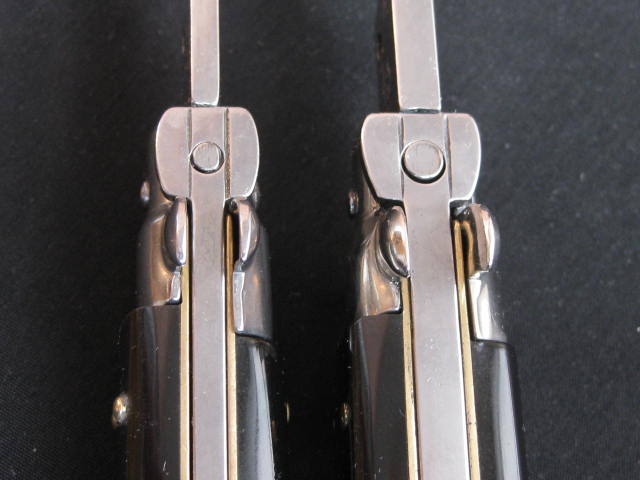
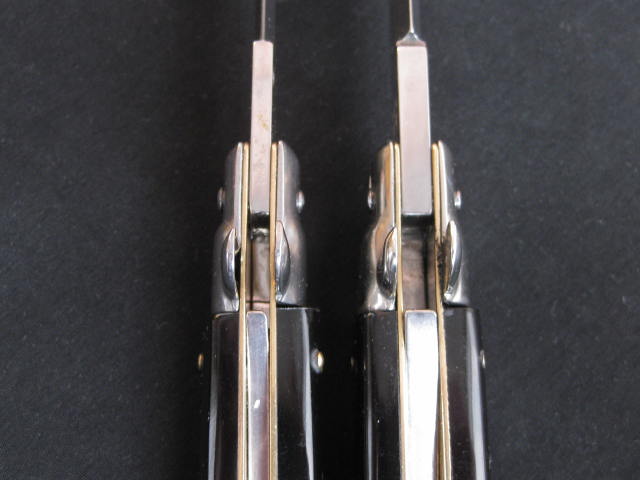
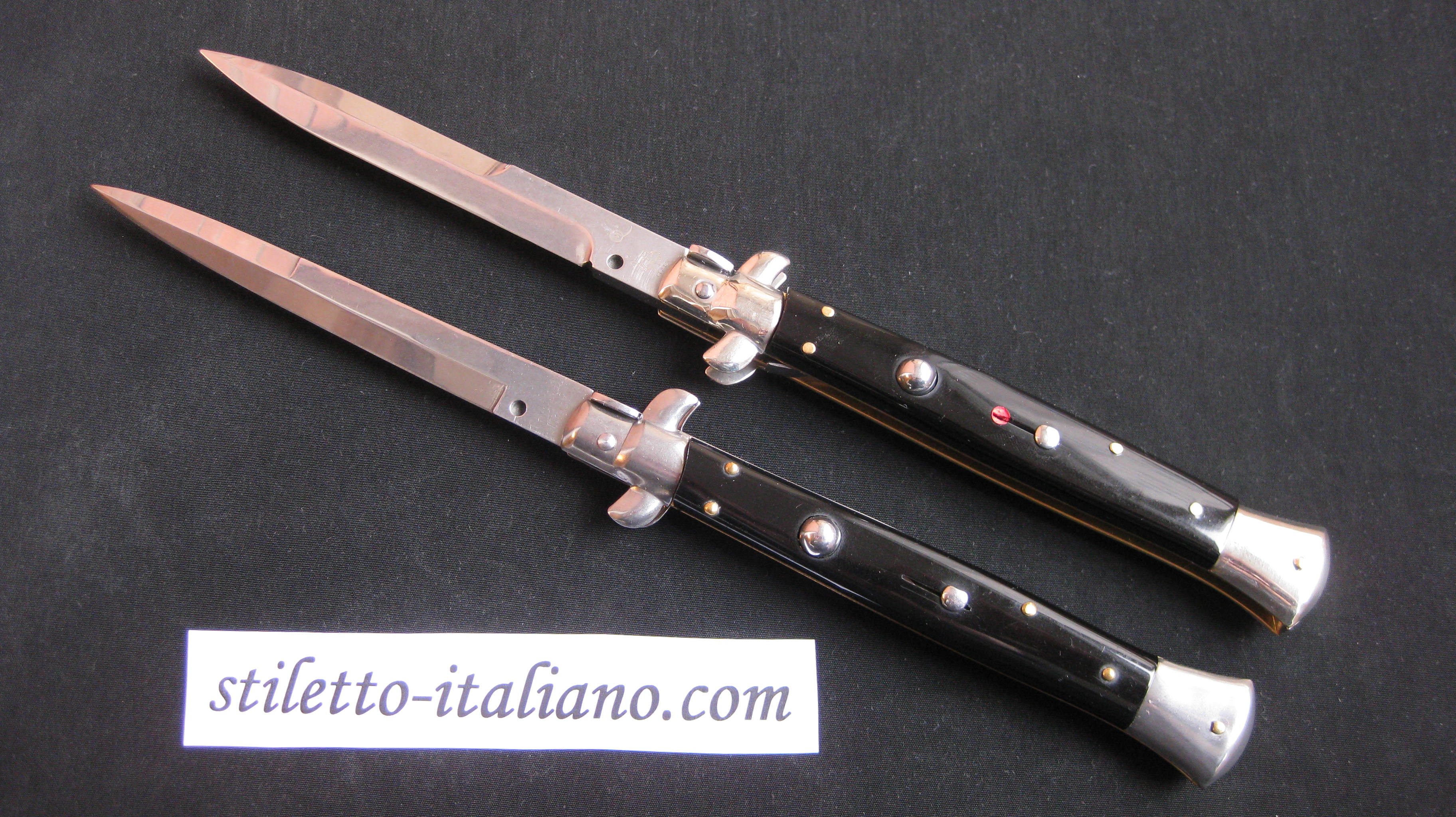
In fact, stilettos LATAMA carried out by the same craftsmen who create a "normal" switchblade stilettos. Details for assembly supplied by the same suppliers as for the "normal" stilettos. The only difference is massive parts for stilettos of LATAMA and more thorough quality control of the assembly. However, modern stilettos branded LATAMA (picture of a cat on the blade)
are more expensive than similar stilettos with stamps Frank.B, AB and AGA Campolin on the above reasons. If we are talking about LATAMA stiletto, produced in 1950, the trading price of some samples can be thousands and even tens of
thousands USD. The photo below shows the stamps of the LATAMA of 1950s and stamp of present times - the image of a cat.
Letter "M" inserted into the letter "Q" means Quality mark.
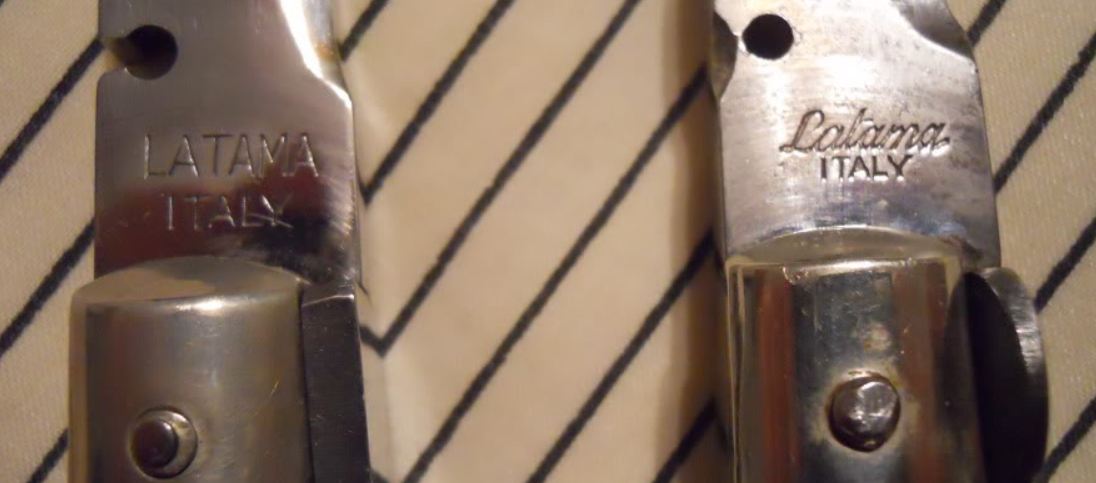
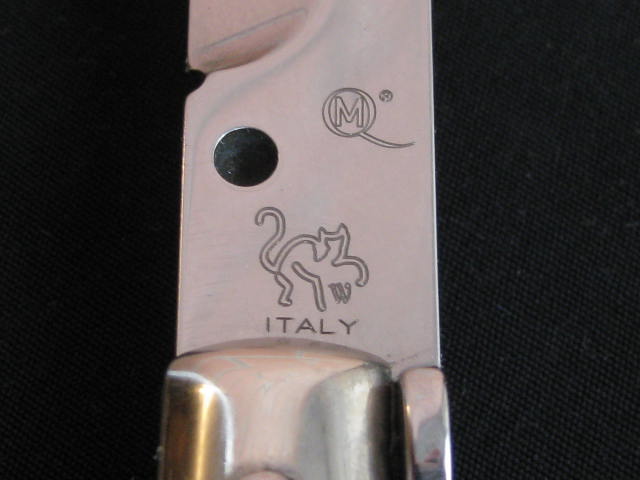
LATAMA means Latin America Import Export Company, the company was founded in the postwar years. Founder of LATAMA was Jacob (Jack) Polinkovsky, born in Russia, in Odessa, about 1888-1890 years. He, his wife and their three year old son (Samuel Polincovsky, born in 1926) moved to Italy in 1929. Since in Odessa Jacob worked in the clothing trade, in Milan, he resumed his activities in the silk trading.
In 1938, when the Nazi racial laws came to Italy, Polinkovskih family moved to the United States, in New York, where Jack Polinkovsky continued to work in garment trade. After the end of World War II, Jack returned to Italy and went on silk exports to South America. This business relationship with South Americans allowed him to call his company The Latin America Import Export Companu abbreviated LATAMA. This shows that originally company LATAMA had nothing with trading knives.
Entry LATAMA into knife trading business happened occasionally. Once Jack Polinkovsky went to Milan for auction silk, but silk was sold out and he stopped his attention on the Britishfolding knives that were used during the war in the British airborne troops. He bought these knives and sold them in Venezuela, where he talks about one of his transactions on the supply of silk, this sale gave a good profit on turnover. Shortly after such a positive experience, he became aware of reviving of the knife industry in Maniago, and he went there to find out about the possibilities of industrialization of knives production. This sphere of activity, just ripe for such a businessman, and Jack did not have any problems with the foundation of what would become one of the greatest associations of automatic knives manufacturers. The photo below shows one of the very British "paratrooper"
knives with which the company LATAMA started operations in the area of exporting knives.
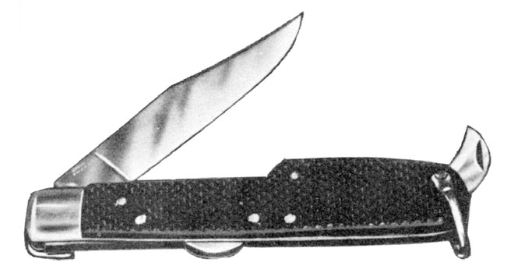
At that time Northern Italy had problems with high-quality steel, the first postwar knives often had springs made from rail parts, and inlays from brass catrige-cases. Polinkovsky solved this problem by agreement with the Austrian company Boehler, regarding the supply of high-quality steel in Maniago. His first enterprise had a contract with knife compny Coricama for the production of scissors at their factory in Caslino and small folding knives in Maniago. After growth of knives sales, he began to contract directly with the knife-makers. Teja & Rosa Knifeworks in Maniago were making small pocket knives, while Romano Matsolli branded Due Cigni (two swans) were producing stilettos with a hollow handle and stainless steel blades. As can be seen from that business practices, LATAMA had not their own factories for the production of knives, and performed as a customer to the Italian knife-makers and then exported knives abroad.
Jack Polinkovski was an astute observer of the market and could see the admiration that causes automatic stilettos on American soldiers and teenagers. In Maniago he hired for the position of supervisor, knife-maker with golden hands - Patrizio Pasquale, and Patrizio, following principles of cottage Industry, existing in Maniago today, concluded agreements with a variety of knife-makers to manufacture knives of different sizes and types branded LATAMA. Jack just appointed as his representative in Maniago Abraham Abramovits, who played a key role in the export of products from Maniago. Jack owned brand stamps throughout the "golden age" of automatic stilettos in Italy.
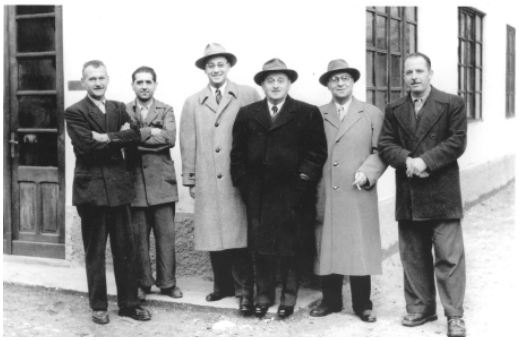
Teja & Rosa Knifeworks - Maniago Italy 1950 г.
From left to right: Teja - knife-maker, Rosa - knife-maker, Sam Polk - son of Latama founder,
Jack Polincovsky founder of Latama, Abram Abramovitz - sales manager of Latama,
Patrizio Pasquale - knife-maker.
In 1949 LATAMA founded in New York and Jack`s son, Sam Polincovsky, reduced its name to Polk, at the age of 23
began working as the executive director of the company, initially as a simple commercial agent driving around, winding miles
with his wife, Claire, and distributing their products. On Broadway, 1123 was a small exhibition hall. Offices were first
on Broadway and in different places of the city, and then in Mt. Vernon, New York. Sam has traveled many roads, selling their knives from New York to the Midwest and even in California. Many stilettos have been sold in New York and Ohio, especially in the Cleveland and Akron. For Jack also worked a number sales agents for commissions and eventually Jack formed a network of wholesale distributors.
The following samples of advertising materials, placed in American men's magazines such as Outdoor Life, Field & Stream and periodicals devoted to military subjects. Due to this advertising were sold a lot of knives. Not all knives were with black handles, although they had such a collective image of advertising called "Black Beauty". After ban the sale of such knives were with the opening by hand, which naturally caused frustration of buyers.Today known not to much blades stamped "Black Beauty".
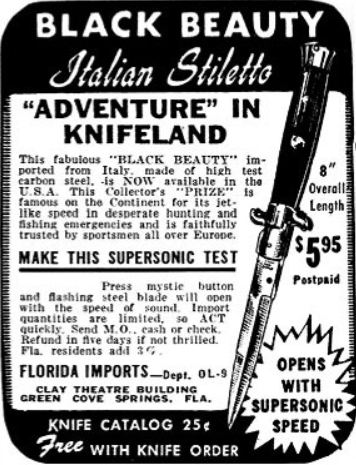
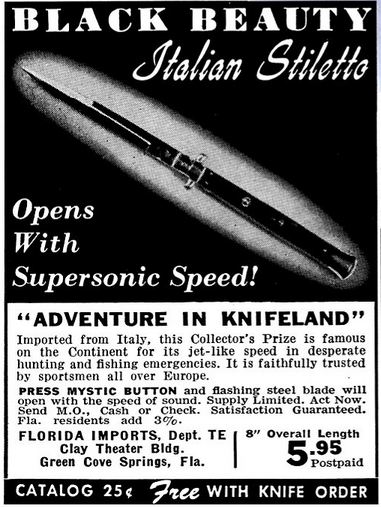
There should be noted that the automatic stilettos made up not significant part of the LATAMA production, which in addition to them, released many other cutting tools such as scissors, pocket knife and other things. In 1950, the company launched a
business selling a variety of items, which explains that its logo can be found on the most different products.
The variety of products was so great that in the two catalogues of late 1940s, automatic knives were mentioned on only
two pages in one, and on three pages in the other. In one of the catalogues, stilettos mentioned twice in novelty section. In these two catalogues of unknown year, but definitely before 1950, mentioned three types of automatic stilettos branded LATAMA: stilettos and gun-knives described as novelties, tourist knives described as hunting and fishing knives. Whatever the company try to distinguish between novelties and hunting and fishing knives, it is clear from the number of
currently available knives, that stilettos were selling in much larger quantities. Today, gun-knives and
tourist knives of LATAMA are extremely rare. Only a small number of collectors has at least one sample, and even
very few can boast having several samples.
.
Belittling the role of automatic knives could be the answer to the clouds that gathered over the knife business (meaning ban of automatic knives in the United States in 1958), or LATAMA just wanted to emphasize that it favors more fashionable goods. Whatever it was, it is automatic stilettos that are now in high demand. Position of the company LATAMA, as an importer of high-quality automatic stilettos, at least in the US, in fact, made the name the company an icon of popular culture, such a reputation could arise only due to circumstances and can not be bought for money or created by most skilled advertisers. Just a question: what exactly made LATAMA dominant in the sphere of automatic stilettos, at least among American collectors? There are three answers to that question, first, LATAMA knives made a little better than most other switchblades of 1950s. Secondly, although LATAMA claimed premium class, its blades are produced in large enough quantities, and even limited quantities of goods allowed to many collectors to purchase one sample. Thirdly, there are different variations of the knives, as listed in the catalog, as well as those that are not expected to produce.
LATAMA stilettos usually has thicker ejector and locking springs, which makes knives more impressive. Handle material - horn looks more attractive, the overall quality of the materials and finishing the blade are better. But the LATAMA knives popularity is more due to magic of the firm name, rather than the quality of its products. LATAMA also tried a lot of experiments and improvements in the knives in a short period of "golden years." Considering that LATAMA were producing switchblades during only 9 years, the number of variations and improvements is very significant. Although it is not possible to date every change in the structure or to determine the beginning and the end of the production of certain models, there is no doubt that LATAMA had been at the forefront of innovative technologies and products, some of which - the result of the prolific mind of Sam Polinkovsky.
But before Polynkovsky contribution, the company had already set some standards in the design of the knives of this kind. First, company benefited from flat guards, impractical to manufacture, but they looked more impressive and better quality, than stamped guards, which appeared later. To increase the rate of production in our time help
stamped guards and the D-brackets. Although none of these advantages does belong exclusively to LATAMA (in Maniago cottage
industry no novelty belong to one person for a long time), yet three innovations distinguish the
company. These innovations - Kris blade gun-knife. Pistol-knife in
where blade is pulled out of the barrel when depress the trigger was copied at least by one manufacturer, but
it is doubtful that such knives are ever interested serious buyers or bandits. Another story with Kris blade.
Quite a lot of manufacturers offer similar blades, called in advertisment zig-zag, besides this type of blade
known in the world long before LATAMA, but LATAMA first began to put these blades on automatic stilettos of length of 9, 11 and 13 inches and special prototypes. Among other innovations LATAMA may be noted sliding safety prevents
the accidental opening of the knife. The photo below shows one of the LATAMA gun-knives.
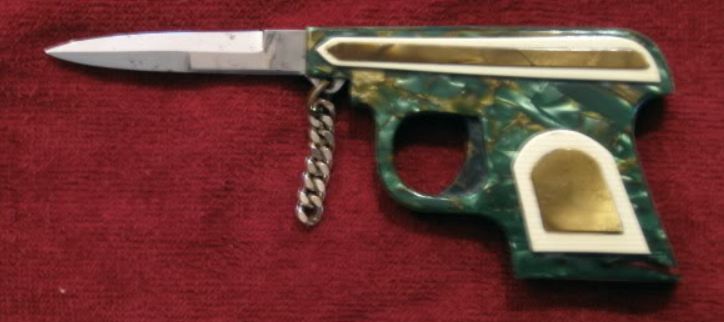
A special place in the history of LATAMA takes most valuable and desired sample of period of the "golden years", automatic stiletto with square button. As is happens with the majority of collectible items, a knife with a square button has been a failure model. However, the product made in sufficient quantities that give collectors a glimmer of hope to get at least one sample. Undoubtedly knife bought a raid of mystery and the value exceeds its own. Recently patents have been found for square button and Kris blade on switchblades, signed by none other than Pasquale Patrizio. Now we know that this knife was invented in 1950, when the patent was issued. The patent was approved in 1952, although the knife was already considered unviable variation. Along with patent on the square button there was patent on Kris blade on switchblade, patent number 35958.
There were various sizes of square buttons - for 16, 20, 23, 33 cm knives, and a button corresponding to each blade size is different from their counterparts. They were all square (but even here with variations) and placed on top of handle, closer to the blade, as opposed to the usual buttons on the picklock stilettos. Perhaps, the most surprising thing with square buttons is that they have unlocked blade using a swivel bolster, method that was not in use until the 1960s, although the idea had been known since the beginning of the 1950s. The photo below presents one of the stilettos with a square button, issued in a limited edition in honor of Sam (Polk) Polincovsky. This stiletto gives an idea of how look like the similar samples in 1950.

After ban of automatic knives in the United States in 1958 , LATAMA stopped importing knives in the United States but continued to manufacture multitool, sharpening kits, scissors and other cutting tools. Sam's father died in 1965, Pasquale Patrizio died in 1976. His son is an architect in Maniago. Abraham Abramowitz lived rest of his days in Maniago and died in 1980. Sam Polk died in 2010, until his recent death he imported silverware from China that were sold throughout the world under the brand of LATAMA/Eleganza. He owned the trademark LATAMA in the US and Italy. Since the days of the "golden years", he owned a restaurant in Tesco, Mexico, where his wife Claire founded a holiday camp for children.
We can say that every fan of Italian automatic stilettos obliged Sam gratitude. Whatever was the name LATAMA, it will always be the standard and measure, which will be compared all the Italian automatic stilettos. Many knives of this type are characterized by "Almost like LATAMA". In fact, it is a great compliment.
Currently the company LATAMA and Frank Beltrame formed a joint venture and produce stilettos "Walt Classic".
Based on "Switchblades of Italy" by Tim Zinser, Dan Fuller, Neal Punchard and latama.net
|
|
|